This first segment is “how to mix front of house” when you also have control live stage monitors, are feeding IEMS (in-ear monitors) and maybe a sub feed out to a streaming mix. When mixing all of these different things from the same console, it forces you into a mode where your gain structure and certain other parameters have to be driven by the other feeds you are mixing, not just the PA. Truly, it isn’t perfect, but it can work.
*In an ideal world you have a monitor engineer, streaming engineer and two more consoles. Lots of $$$$$$$ Good Luck!

So, the first thing you have to look at is how much gain is required to feed the IEM direct outs to get good signal-to-noise. Inadequate levels with whatever types of headphones/in-ears the individual musicians are using leads to excessive IEM Noise.
Tip=> everyone’s IEM’s needs to have high sensitivity at least 107 dB. If that’s not the case, you may have to have enough gain to handle the lower output devices that people might be using..
So your Gain structure is initially driven by what needs to go to the IEM and direct outs. Busses will also be used for IEM feeds so you’ve also got to look at things that need to be grouped into the IEM. Also determine which feeds are pre EQ, compressor etc.…. and which aren’t. People always say give me a pre everything feed, but that is not always the best choice for live or IEM. (Ear Damage i.e. accidents)
You may not want to have EQ applied to certain aspects. The last thing you want to do is have any EQ you’re doing at front of house affect, let’s say a bass player and what they’re hearing in their in hears. On most consoles there’s a variety of feed options with direct outs, buss outs, other ways of getting signal to an IEM with or without mute with or without EQ with or without gain adjustment.
Vocals vs. Godzilla
When you deal with a group of vocals however, it’s very important that what you’re doing at front of house does translate into the in IEM ears and floor wedges. For example, you have six vocalists and one of them goes “Godzilla” on you and is much louder than the other five.

At front of house you have to pull that one singer down to save the mix. (It’s a rescue operation!) You want that change to translate to the IEM mix (and floor wedges). So they get fed off of a post fader group buss. (On most consoles it’s not called a “group.” It’s called a “buss.”) On a buss, send every EQ change and every gain change that you make on the vocals does translate to the in-ears and it also translates to the floor monitors.
Similar issues anyone else using live wedges.
Note – do not let these people have stage IEM control boxes to mix their own mix. This basically becomes a second sound system, being run by a musician. You need control of all wedges or your mix will be destroyed by your other “sound people” on stage.
Floor Wedges
You’ve got another anomaly you have to look at when you have floor wedges that are primarily giving keyboard and in some cases click cues to the musicians that aren’t using any ears, which most often are the vocalists.
The question is do you make these pre fader or do you make these post fader? Now the prevailing wisdom would be make that pre fader because you wouldn’t want front of house changes to make it disappear.
The reality, however, is that when you do that, the tonality in the front of house is constantly changing due to the unchanging monitor mix. If you pull a fader down on the keyboard FOH, the monitor bleed, which is a completely different frequency set and is out of phase and creating comb filtering is at a higher level than what’s coming out of the PA. Can sound pretty bad.
So the best solution is to actually keep a set of in-ears handy at front of house or a really good set of headphones, mix everything post fader – keyboards, guitars, everything else that’s going into the monitors.
You have to check the monitor mix levels by soloing up that bus to see what the blend is and make sure that with vocals there’s enough keyboards and other instruments there that they can get all of their frequency cues and all of their timing cues from the click track. So you want that to be there but not overbearing.
Streaming
The feed to streaming is a similar scenario. Drums in the live mix do not need to be that loud in the house. Kick drum does, but unless they are in a separate room, most everything else does not. However, what needs to go to the streaming mix is all of it.
So you need to create a buss mix that allows you to get a better mix to streaming than you would get if you just left it alone. This has to be post EQ fader etc….. so your FOH changes affect that feed. And, you have to listen to it once in a while. Okay, so that kind of ends the basic session there about big gain structure, etc…
Also assign a good gain limiting device to that bus overall, and set it so on quiet songs it is barely set on working, on RMS. Use one that simulates a vintage comp/limiter.
It’s still not a good choice compared to mixing on a separate console, but if you pay attention it can work.
Copyright AVLDESIGNSINC 2021+
